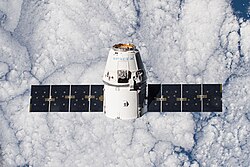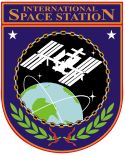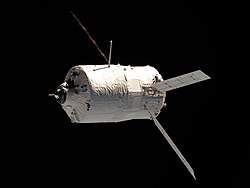ATV-003 Edoardo Amaldi
| ATV-003 Edoardo Amaldi | |||
 | |||
| Uppkallad efter | Edoardo Amaldi | ||
|---|---|---|---|
| Modell | Automated Transfer Vehicle | ||
| Färdens tid | 193 dagar, 20 timmar | ||
| Massa | ~20 000 kg | ||
| NSSDC-ID | 2012-010A[1] | ||
| Uppskjutning | |||
| Startplats | ELA 3 Centre Spatial Guyanais | ||
| Raket | Ariane 5 ES ATV | ||
| Uppskjutning | 23 mars 2012, 04:31 UTC | ||
| Återinträde | |||
| Återinträde | 3 oktober 2012 | ||
| Omloppsbana | |||
| Apogeum | 255 km | ||
| Perigeum | 252 km | ||
| Banlutning | 51,6° | ||
| Varv | 3 018 st[2] | ||
| Dockning | |||
| Rymdstation | ISS | ||
| Dockning | 28 mars 2012, 22:51 UTC | ||
| Dockningsport | Zvezda Akter | ||
| Ur dockning | 28 september 2012, 21:44 UTC | ||
| Kronologi | |||
| |||
ATV-003 Edoardo Amaldi var ESA:s tredje Automated transfer vehicle för att leverera förnödenheter, syre, vatten och bränsle till rymdstationen ISS. Uppskjutningen skedde den 23 mars 2012. Den dockade med rymdstationen den 28 mars 2012. Farkosten var dockade med stationen fram till den 28 september 2012. ATV-003 brann upp i jordens atmosfär den 3 oktober 2012.
Farkosten var uppkallad efter den italienske fysikern Edoardo Amaldi.
Källor
Fotnoter
- ^ ”NASA Space Science Data Coordinated Archive” (på engelska). https://nssdc.gsfc.nasa.gov/nmc/spacecraft/display.action?id=2012-010A. Läst 26 februari 2020.
- ^ Manned Astronautics - Figures & Facts Arkiverad 3 oktober 2015 hämtat från the Wayback Machine., läst 28 juli 2016.
| |||||||||||||
| ||||||||||||||||||||||||||||||||
Media som används på denna webbplats
This image, photographed by one of the Expedition 42 crew members aboard the International Space Station, shows the SpaceX Dragon cargo craft approaching on Jan. 12 2015 for its grapple and berthing and the start of a month attached to the complex. Dragon carried more than 2 ½ tons of supplies and experiments to the station.
ISS021-E-017623 (30 Oct. 2009) --- Backdropped by a cloud-covered part of Earth, the unpiloted Japanese H-II Transfer Vehicle (HTV), filled with trash and unneeded items, departs from the International Space Station. European Space Agency astronaut Frank De Winne, Expedition 21 commander; NASA astronaut Nicole Stott and Canadian Space Agency astronaut Robert Thirsk, both flight engineers, used the station's Canadarm2 robotic arm to grab the HTV cargo craft and unberth it from the Harmony node's nadir port. The HTV was successfully unberthed at 10:18 a.m. (CDT) on Oct. 30, 2009, and released from the station's Canadarm2 at 12:32 p.m.
European Space Agency's "Edoardo Amaldi" Automated Transfer Vehicle-3 (ATV-3) approaches the International Space Station. The unmanned cargo spacecraft docked to the space station at 6:31 p.m. (EDT) on March 28, 2012, delivering 220 pounds of oxygen, 628 pounds of water, 4.5 tons of propellant, and nearly 2.5 tons of dry cargo, including experiment hardware, spare parts, food and clothing.
A Progress supply ship linked up to the orbiting International Space Station (ISS) at 3:48 GMT, November 18, bringing Expedition 1 commander William M. Shepherd, pilot Yuri P.
Gidzenko and flight engineer Sergei K. Krikalev two tons of food, clothing, hardware and holiday gifts from their families. The photograph was taken with a 35mm camera and the film was later handed over to the STS-97 crew members
for return to Earth and subsequent processing.Drawing of ESA's Automated Transfer Vehicle
Backdropped by a cloud-covered part of Earth, the Orbital Sciences' Cygnus cargo craft approaches the International Space Station, photographed by an Expedition 40 crew member. The two spacecraft converged at 6:36 a.m. (EDT) on July 16, 2014.
ISS026-E-037172 (24 Feb. 2011) --- Surrounded by the blackness of space, the European Space Agency's "Johannes Kepler" Automated Transfer Vehicle-2 (ATV-2) approaches the International Space Station. Docking of the two spacecraft occurred at 10:59 a.m. (EST) on Feb. 24, 2011.









